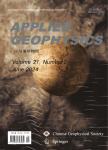Three-dimensional tensor controlled-source electromagnetic modeling based on the vector finite-element method
基于矢量有限元法的三维张量CSAMT正演模拟(英文)作者机构:吉林大学地球探测科学与技术学院长春130026 中国地质调查局天津地调中心天津300170 中国地质科学院地球物理地球化学勘查研究所廊坊065000 山东科技大学地质科学与工程学院青岛266590
出 版 物:《Applied Geophysics》 (应用地球物理(英文版))
年 卷 期:2015年第12卷第1期
页 面:35-46,121页
核心收录:
学科分类:081801[工学-矿产普查与勘探] 081802[工学-地球探测与信息技术] 0707[理学-海洋科学] 08[工学] 0708[理学-地球物理学] 0818[工学-地质资源与地质工程] 0825[工学-航空宇航科学与技术] 0704[理学-天文学]
基 金:supported by the National Natural Science Foundation of China(No.41104068) the Deep Exploration in China,Sino Probe-03-05
主 题:CSAMT model impedance tensor VFEM
摘 要:Scalar CSAMT is only suitable for measurements in one and two dimensions perpendicular to geological structures. For complex 3D geoelectric structure, tensor CSAMT is more suitable. In this paper, we discuss 3D tensor CSAMT forward modeling using the vector finite-element method. To verify the feasibility of the algorithm, we calculate the electric field, magnetic field, and tensor impedance of the 3D CSAMT far-zone field in layered media and compare them with theoretical solutions. In addition, a three-dimensional anomaly in half-space is also simulated, and the response characteristics of the impedance tensor and the apparent resistivity and impedance phase are analyzed. The results suggest that the vector finite-element method produces high-precision electromagnetic field and impedance tensor data, satisfies the electric field discontinuity, and does not require divergence correction using the vector finite-element method.



